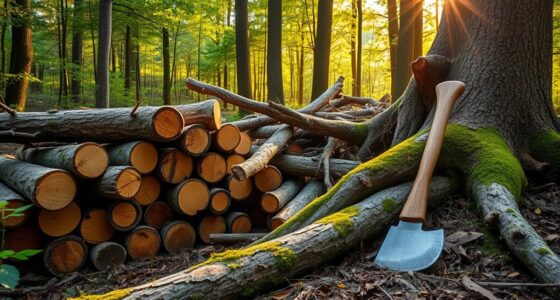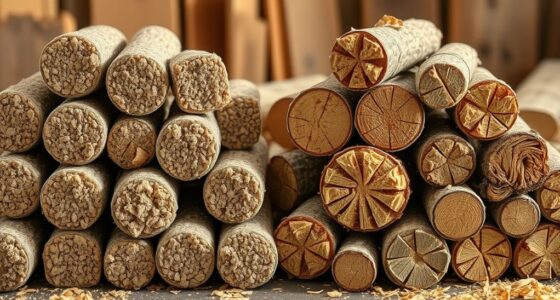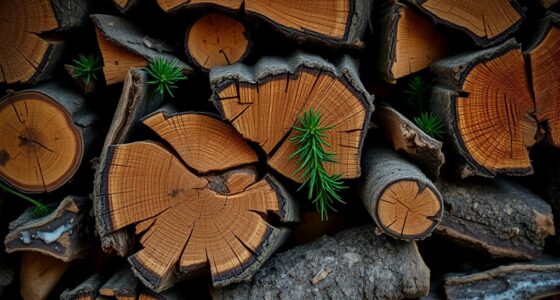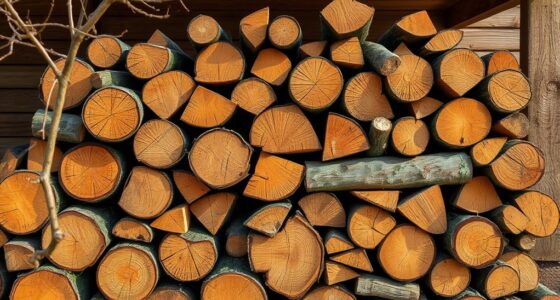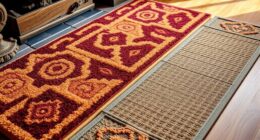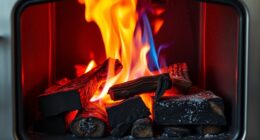To verify if your firewood is dry, use a moisture meter by inserting its prongs into the center of a split piece, avoiding edges. Take multiple readings across different pieces and spots to guarantee accuracy. Make sure the meter is properly calibrated using a standard or seasoned wood with a known moisture level. Correct use and regular calibration help you determine if your wood is at the ideal 15-20% moisture. Keep going to find out more tips for safe, efficient fires.
Key Takeaways
- Insert meter prongs into the center of a split firewood piece, avoiding edges for accurate readings.
- Calibrate the moisture meter regularly using a known standard or calibration block for precision.
- Take multiple readings from different pieces and locations to ensure consistent moisture levels.
- Ensure the moisture content is between 15-20% before burning for optimal combustion and safety.
- Consider environmental factors like humidity, and re-calibrate if conditions change or after non-use.

When it comes to guaranteeing your firewood burns efficiently and safely, checking its moisture content is vital. Using a moisture meter allows you to do this quickly and accurately, helping you determine whether your wood is ready for burning. But to get reliable readings, you need to be confident that your moisture meter is properly calibrated. Moisture meter calibration involves testing the device against a known moisture standard, ensuring that the readings you receive reflect the actual moisture content of your firewood. If your meter isn’t calibrated correctly, you risk either over-drying your wood—causing it to crack and produce more creosote—or using wood that’s too wet, which leads to inefficient burning, excess smoke, and dangerous creosote buildup in your chimney.
Understanding the ideal moisture levels for firewood is vital. Typically, seasoned firewood should have a moisture content between 15% and 20%. Wood with moisture levels above 20% is considered green or unseasoned, meaning it contains too much water to burn efficiently. Burning green wood not only produces less heat but also results in more smoke and creosote, increasing the risk of chimney fires. On the other hand, wood with moisture levels below 15% is considered well-seasoned and burns cleaner and hotter. Keeping your firewood within these ideal moisture levels guarantees safer, more efficient fires that produce less creosote and reduce pollution.
To accurately measure moisture levels, you should regularly check your moisture meter’s calibration. Most meters come with calibration settings or reference standards. You can calibrate your device using a sample of seasoned wood known to have a specific moisture content or a calibration block provided by the manufacturer. Proper calibration guarantees that your readings are precise, which is especially important if you’re storing firewood for the entire season. Remember, environmental factors like humidity can affect moisture readings, so calibrate your meter periodically, especially when switching between different types of wood or after extended periods of non-use. Additionally, understanding airless paint sprayer tips can help ensure your tools are well-maintained for various home projects.
Using your moisture meter correctly also involves knowing where to test on the firewood. Insert the prongs into the center of a split piece, avoiding the edges, which can have different moisture levels. Take multiple readings across different pieces and locations to get a representative understanding of your wood’s overall dryness. Once you confirm that your firewood measures within the ideal moisture levels, you can confidently burn it, knowing you’re maximizing heat output, minimizing smoke, and maintaining a safer chimney environment. Regularly checking and calibrating your moisture meter is a simple step that makes a significant difference in how efficiently and safely your fires burn.
Frequently Asked Questions
Can Moisture Meters Determine the Best Firewood Species for Burning?
Moisture meters can’t directly determine the best firewood species for burning efficiency. Instead, they measure the moisture content of any firewood you select. To maximize burning efficiency, you should choose species known for high energy content and good burning qualities, like oak or hickory. Using a moisture meter helps guarantee your firewood is properly dried, regardless of species, which is vital for efficient, clean burning.
How Often Should I Recheck Firewood Moisture Levels During Storage?
You should recheck your firewood moisture levels at least every few weeks during storage, especially through seasonal changes. Changes in temperature and humidity can dramatically affect dryness, making your wood as unpredictable as a wild stallion. Regular checks with a moisture meter make sure your firewood stays below 20% moisture content, so it burns efficiently and safely. Keep an eye on it, and don’t let it become unexpectedly damp or dry.
Are Digital Moisture Meters More Accurate Than Analog Ones?
Digital moisture meters are generally more accurate than analog ones because they have precise digital calibration, providing consistent readings. They often feature advanced sensors that detect moisture levels more reliably. However, analog meters are known for their durability, making them suitable for rough conditions. If accuracy is your priority, opt for a digital meter, but if you need something long-lasting, an analog device might serve you better.
Can Moisture Meters Detect Internal Moisture in Split Logs?
Yes, moisture meters can detect internal moisture in split logs. When you use a moisture meter properly, it measures the internal moisture content by inserting the probe into the wood. This is especially useful for split logs, as the moisture level inside can differ from the surface. By checking internal moisture, you guarantee your firewood is properly dried, which leads to better burning and less creosote buildup.
Is There a Recommended Moisture Level for Different Types of Fireplaces?
For ideal burning, you should follow moisture level guidelines tailored to your fireplace type. Generally, seasoned firewood should have a moisture content below 20%, which ensures efficient burning and reduces creosote buildup. For indoor fireplaces, aim for 15-20%, while outdoor fire pits can handle slightly higher levels. Proper firewood seasoning and adhering to moisture level guidelines help you achieve safer, cleaner, and more efficient fires every time.
Conclusion
By using a moisture meter, you’re gently guiding your firewood towards its perfect moment of readiness. It’s like giving your wood a friendly nudge to guarantee it’s just dry enough for a warm, cozy fire. With this simple tool, you avoid the pitfalls of overly damp or overly dried wood, making your fires more enjoyable. So, think of the moisture meter as your helpful companion on the journey to a perfect, crackling fire every time.




